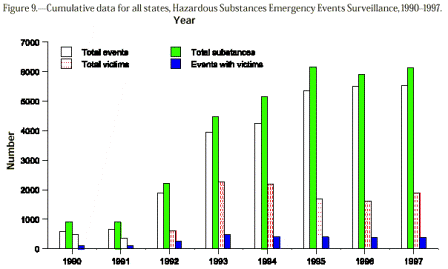- DISCLAIMER
- LIST OF TABLES
- LIST OF FIGURES
- LIST OF APPENDICES
- EXECUTIVE SUMMARY
- INTRODUCTION
- METHODS
- RESULTS
- SULFURIC ACID
- USE OF HSEES DATA
- SUMMARY OF RESULTS, 1990 - 1997
- REFERENCE
- APPENDICES
- Table 1
Number of events meeting the surveillance definition, by state and type of event, Hazardous Substances Emergency Events Surveillance, 1997 - Table 2
Distribution of the number of substances released, by type of event, Hazardous Substances Emergency Events Surveillance, 1997 - Table 3
Distribution of the number of substances released, by substance category and type of event, Hazardous Substances Emergency Events Surveillance, 1997 - Table 4
Distribution of the number of victims by type of event, Hazardous Substances Emergency Events Surveillance, 1997 - Table 5
Number of substances released in all events and events with victims, by substance category, Hazardous Substances Emergency Events Surveillance, 1997 - Table 6
Distribution of type of injury by type of event, Hazardous Substances Emergency Events Surveillance, 1997 - Table 7
Cumulative data for all states, Hazardous Substances Emergency Events Surveillance, 1990 - 1997 - Figure 1
Areas of fixed facilities involved in events, Hazardous Substances Emergency Events Surveillance, 1997 - Figure 2
Distribution of transportation-related events, by type of transport, Hazardous Substances Emergency Events Surveillance, 1997 - Figure 3
Factors reported as contributing to the occurrence of fixed-facility events, Hazardous Substances Emergency Events Surveillance, 1997 - Figure 4
Distribution of victims by population group and type of event, Hazardous Substances Emergency Events Surveillance, 1997 - Figure 5
Distribution of responder victims by population group and type of event, Hazardous Substances Emergency Events Surveillance, 1997 - Figure 6
Distribution of type of injury for all events, Hazardous Substances Emergency Events Surveillance, 1997 - Figure 7
Injury outcome, Hazardous Substances Emergency Events Surveillance, 1997 - Figure 8
Distribution of victims, Hazardous Substances Emergency Events Surveillance, 1990 - 1997 - Figure 9
Cumulative data for all states, Hazardous Substances Emergency Events Surveillance, 1990 - 1997 - Appendix A
The 100 Most Frequently Released Substances, Hazardous Substances Emergency Events Surveillance, 1997 - Appendix B
Hazardous Substances Emergency Events Surveillance-Related Publications - To describe the distribution and characteristics of hazardous substances emergencies.
- To describe the morbidity and mortality experienced by
employees, responders, and the general public as a result
of hazardous substances releases.
- To identify risk factors associated with the morbidity and
mortality.
- To identify strategies that might reduce future morbidity and mortality resulting from the release of hazardous substances.
Download Adobe Acrobat (PDF) version - 1.86 MB
Historical Document
This document is provided by the Agency for Toxic Substances and Disease Registry (ATSDR) ONLY as an historical reference for the public health community. It is no longer being maintained and the data it contains may no longer be current and/or accurate.
This publication reports the results and findings of a health study, registry, or other health-related activity supported by ATSDR in accordance with its legislative mandate described above.
Comments regarding this report are welcome. Please address to:
Agency for Toxic Substances and Disease RegistryAttn: Director, Division of Health Studies (E-31)
1600 Clifton Road, N.E.
Atlanta, Georgia 30333
Agency for Toxic Substances and Disease Registry
Jeffrey Koplan, MD, MPH, Administrator
Henry Falk, MD, MPH, Assistant Administrator
Robert F. Spengler, ScD, Associate Administrator for Science
Division of Health Studies
Jeffrey A. Lybarger, MD, MS, Director
Sharon S. Campolucci, MSN, Deputy Director
Connie L. Whitehead, Editor
Epidemiology and Surveillance Branch
Hazardous Substances Emergency Events Surveillance Staff
Wendy E. Kaye, PhD, Chief
Sean Buckley, MPH
Gilbert S. Haugh, MS
Maureen Orr, MS
Patricia Price-Green, MSPH
Casetta R.Simmons
DISCLAIMER
Mention of the name of any company or product does not constitute endorsement by the Agency for Toxic Substances and Disease Registry, the Public Health Service, or the U.S. Department of Health and Human Services.
CONTENTS
LIST OF TABLES
LIST OF FIGURES
LIST OF APPENDICES
EXECUTIVE SUMMARY
Since 1990, the Agency for Toxic Substances and Disease Registry (ATSDR) has maintained an active, state-based Hazardous Substances Emergency Events Surveillance (HSEES) system to describe the public health consequences associated with the release of hazardous substances. Five state health departments participated in the pilot phase of the surveillance system and began data collection on January 1, 1990. Since 1990, the number of participating state health departments has increased, with the largest number of participating states being 14 in 1995 and 1996. In 1997, the New Hampshire Department of Health and Human Services voluntarily withdrew from the HSEES system. This report summarizes the characteristics of events reported to the surveillance system by 13 state health departments during 1997.
Information on acute hazardous substances emergency events was collected. The types of data collected included general information on the event, substance(s) released, victims, injuries, and evacuations.
Several data sources were used to obtain the maximum amount of information about each event. These sources included, but were not limited to, records or oral reports of state environmental protection agencies, police and fire departments, and hospitals. The data obtained were computerized using an ATSDR-provided data entry system and were sent to ATSDR quarterly.
The 13 states reported a total of 5,531 events for 1997; approximately 80% of the events occurred at fixed facilities, and 20% were transportation related. In 96% of the events, only a single substance was released. The most commonly reported categories of substances were volatile organic compounds; acids; ammonia; pesticides; other inorganic substances; mixtures involving more than one category; and the category designated "other", which included substances that could not be placed in one of the other 10 categories. During this reporting period, 372 events (approximately 7% of all events) resulted in a total of 1,896 victims. The most frequently reported injuries sustained by victims were respiratory irritation, headache, eye irritation, and nausea or vomiting. A total of 28 persons died as a result of all events, and 514 events required evacuations.
The findings regarding the distribution of the types of events, the numbers of events with victims and evacuations, and the injuries reported have, overall, been consistent since HSEES was begun.
INTRODUCTION
Since 1990, the Agency for Toxic Substances and Disease Registry (ATSDR) has maintained an active, state-based Hazardous Substances Emergency Events Surveillance (HSEES) system to describe the public health consequences associated with the release of hazardous substances. The decision to initiate a surveillance system of this type was based on a 1988 study on the reporting of hazardous substances releases to three national databases: the National Response Center Database, the Hazardous Materials Information System (HMIS), and the Acute Hazardous Events Database (1). A review of these databases indicated that they were limited because many events were missed through incomplete reporting (for example, the HMIS does not include events involving intrastate carriers or fixed-facility events). Other missing information included the demographic characteristics of victims, the types of injuries received, and the number of persons evacuated. As a result of this review, ATSDR implemented the HSEES system to describe the public health consequences associated with the release of hazardous substances. The surveillance system has four goals:
This report summarizes the characteristics of hazardous substances releases and the associated public health consequences of events reported to the surveillance system during 1997.
METHODS
In 1997, 13 state health departments (Alabama, Colorado, Iowa, Minnesota, Mississippi, Missouri, New York, North Carolina, Oregon, Rhode Island, Texas, Washington, and Wisconsin) collected data for HSEES. Information was collected on standardized data collection forms. Information about the event, substance(s) released, victims, injuries, and evacuations was collected.
Various data sources were used to obtain information about these events. These sources included, but were not limited to, records and oral reports of state environmental protection agencies, police and fire departments, and hospitals. Census data were used to estimate the number of residents in the vicinity of the events. All of the data were computerized using an ATSDR-provided data entry system and were sent to ATSDR quarterly.
Hazardous substances emergency events were defined as uncontrolled or illegal releases or threatened releases of hazardous substances or the hazardous by-products of substances. Not included were events involving petroleum products exclusively. Events were included if (1) the amount of substance that was released, or that might have been released, needed (or would have needed) to be removed, cleaned up, or neutralized according to federal, state, or local law; or (2) there was only a threatened release of a substance, but this threat led to an action (for example, evacuation) that could have affected the health of employees, responders, or the general public. Victims were defined as those persons who had at least one injury or died as a consequence of the event. When counting injuries, victims who had more than one injury type were counted more than once. Events were defined as transportation related if they occurred during surface, air, or water transport of hazardous substances. Fixed-facility events were defined as events occurring at industrial sites, schools, farms, or any other type of facility.
For the analyses, the substances released were categorized into 11 groups. The category "mixtures" consisted of mixtures of substances from different categories, and the category "other" consisted of substances that could not be placed in one of the other 10 substance categories. The category "other inorganic substances" comprised all inorganic substances except for acids, bases, ammonia, and chlorine.
RESULTS
A total of 5,531 events were reported in 1997 to the HSEES system by the 13 participating state health departments; of these events, about 1% were only threatened releases. Eighty percent of the events occurred at fixed facilities, and 20% were transportation related (Table 1).
Thirty-seven percent of fixed-facility events were reported as involving a process vessel, which is the reaction chamber where chemicals are processed (Figure 1). Fifteen percent involved a type of processing reported as "other", 13% involved storage above ground, 13% involved a combination of types of areas, and 9% involved material handling. The remaining events involved a variety of areas or the areas were unknown. In transportation-related events, 81% occurred during ground transport (for example, truck, van, or tractor), and 14% involved
transport by rail (Figure 2). The remaining transportation-related events primarily involved water, air, or pipeline transport.
Factors contributing to fixed-facility events were also reported (Figure 3). In the 4,395 fixed-facility events, 2,597 (59%) involved equipment failure as a contributing factor to the occurrence of the event. A total of 748 (17%) fixed-facility events were reported as involving operator error and 114 (3%) as involving improper filling procedures or overfill.
Ninety-six percent of the events involved the release of only one substance. Two substances were released in approximately 2% of the events, and the remainder involved the release of more than two substances (Table 2).
Most releases were either liquid spills (45%) or air emissions (39%). The remaining releases resulted from fires (4%) or other types or combinations of types of releases (12%).
Events occurred primarily from 6:00 AM to 12 noon (37%) and from 12 noon to 6:00 PM (32%). Approximately 19% of events occurred on a Saturday or Sunday.
Substances
Of the 11 categories into which HSEES substances were grouped, other inorganic substances (24%), volatile organic compounds (VOCs) (23%), other substances (16%), mixtures (11%), and acids (7%) were the categories of substances most commonly released in fixed-facility events (Table 3). In transportation-related events, pesticides (15%), other inorganic substances (15%), acids (13%), VOCs (11%), and other substances (26%) were most frequently released. The 100 substances most frequently reported to HSEES for 1997 are listed in Appendix A.
Table 1.--Number of events meeting the surveillance definition, by state and type of event, Hazardous Substances Emergency Events Surveillance, 1997.
|
STATE REPORTING EVENT |
TYPE OF EVENT |
TOTAL NO. OF EVENTS | |||
| FIXED FACILITY | TRANSPORTATION | ||||
| NO. OF EVENTS | (%) | NO. OF EVENTS | (%) | ||
| Alabama | 122 | (81.3) | 28 | (18.7) | 150 |
| Colorado | 148 | (48.5) | 157 | (51.5) | 305 |
| Iowa | 186 | (60.6) | 121 | (39.4) | 307 |
| Minnesota | 194 | (73.2) | 71 | (26.8) | 265 |
| Mississippi | 85 | (70.8) | 35 | (29.2) | 120 |
| Missouri | 113 | (61.7) | 70 | (38.3) | 183 |
| New York | 366 | (89.9) | 41 | (10.1) | 407 |
| North Carolina | 117 | (73.6) | 42 | (26.4) | 159 |
| Oregon | 104 | (63.0) | 61 | (37.0) | 165 |
| Rhode Island | 27 | (73.0) | 10 | (27.0) | 37 |
| Texas | 2,457 | (90.6) | 255 | (9.4) | 2,712 |
| Washington | 260 | (70.1) | 111 | (29.9) | 371 |
| Wisconsin | 216 | (61.7) | 134 | (38.3) | 350 |
| Total | 4,395 | (79.5) | 1,136 | (20.5) | 5,531 |
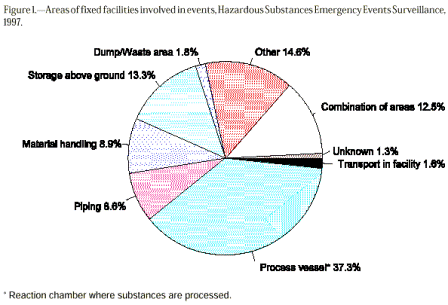
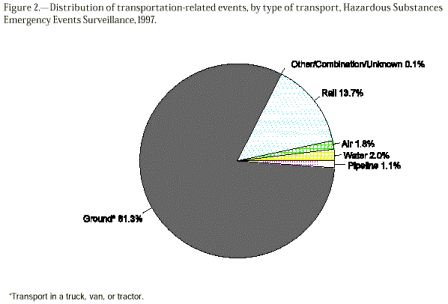
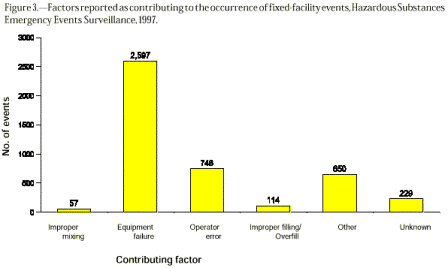
Table 2.--Distribution of the number of substances released, by type of event, Hazardous Substances Emergency Events Surveillance, 1997.
| NO. OF SUBSTANCES RELEASED | TYPE OF EVENT | ALL EVENTS | |||||||
| FIXED FACILITY | TRANSPORTATION | ||||||||
| NO. OF EVENTS | (%) | NO. OF SUBSTANCES | NO. OF EVENTS | (%) | NO. OF SUBSTANCES | NO. OF EVENTS | (%) | NO. OF SUBSTANCES | |
| 1 | 4,260 | (96.9) | 4,260 | 1,066 | (93.8) | 1,066 | 5,326 | (96.3) | 5,326 |
| 2 | 82 | (1.9) | 164 | 43 | (3.8) | 86 | 125 | (2.3) | 250 |
| 3 | 19 | (0.4) | 57 | 13 | (1.1) | 39 | 32 | (0.6) | 96 |
| 4 | 7 | (0.2) | 28 | 7 | (0.6) | 28 | 14 | (0.3) | 56 |
| 5 | 9 | (0.2) | 45 | 2 | (0.2) | 10 | 11 | (0.2) | 55 |
| 6 | 18 | (0.4) | 285 | 5 | (0.4) | 56 | 23 | (0.4) | 341 |
| Total | 4,395 | (100.0) | 4,839 | 1,136 | (100.0) | 1,285 | 5,531 | (100.0) | 6,124 |
Table 3.--Distribution of the number of substances released, by substance category and type of event, Hazardous Substances Emergency Events Surveillance, 1997.
| SUBSTANCE CATEGORY | TYPE OF EVENT | ALL EVENTS | ||||
| FIXED FACILITY | TRANSPORTATION | |||||
| NO. OF SUBSTANCES | (%) | NO. OF SUBSTANCES | (%) | NO. OF SUBSTANCES | (%) | |
| Acids | 350 | (7.2) | 161 | (12.5) | 511 | (8.3) |
| Ammonia | 331 | (6.8) | 54 | (4.2) | 385 | (6.3) |
| Bases | 135 | (2.8) | 76 | (5.9) | 211 | (3.4) |
| Chlorine | 110 | (2.3) | 10 | (0.8) | 120 | (2.0) |
| Mixtures* | 517 | (10.7) | 56 | (4.4) | 573 | (9.4) |
| Other inorganic substances | 1,155 | (23.9) | 189 | (14.7) | 1,344 | (21.9) |
| Other substances | 782 | (16.2) | 335 | (26.1) | 1,117 | (18.2) |
| Paints and dyes | 74 | (1.5) | 61 | (4.7) | 135 | (2.2) |
| Pesticides | 198 | (4.1) | 189 | (14.7) | 387 | (6.3) |
| Polychlorinated biphenyls | 81 | (1.7) | 7 | (0.5) | 88 | (1.4) |
| Volatile organic compounds | 1,106 | (22.9) | 147 | (11.4) | 1,253 | (20.5) |
| Total | 4,839 | (100.0) | 1,285 | (100.0) | 6,124 | (100.0) |
* Mixtures of substances from different categories.
Victims
A total of 1,896 victims were involved in 372 events (7% of all events) (Table 4). Of the events with victims, 51% involved only one victim, and 69% involved either one or two victims. Most (91%) victims were injured in fixed-facility events.
The substances released most often were not necessarily the most likely to result in victims (Table 5). For example, VOCs were released during 1,253 events; however, only 46 (4%) of these events resulted in injury. Although chlorine was released in only 120 events, 34 (28%) of these events resulted in injury, indicating its greater potential for immediate harm.
The population groups most often injured were employees (62%) and the general public (31%) (Figure 4). Of the responders who were injured in fixed-facility events, the affiliation was unknown for 34%; of the remainder, 15% were emergency medical technicians; 15%, firefighters, pay status unknown; 14%, police; and 14%, professional firefighters (Figure 5). There were 10 responder victims involved in transportation-related events. Of these victims, 50% were police officers, and 30% were responders of unknown affiliation.
The types of injuries sustained by victims are shown in Table 6 and in Figure 6. The victims sustained a total of 3,145 injuries. Some victims had more than one injury. The most commonly reported injuries in fixed-facility events were respiratory irritation (39%), headache (13%), nausea or vomiting (12%), and eye irritation (12%). In transportation-related events, trauma (41%), respiratory irritation (18%), eye irritation (8%), and headache (7%) were reported most frequently. Trauma was reported in 41% of transportation-related events and only 2% of fixed-facility events. The trauma might have been caused by the sequence of events (for example, a motor vehicle accident) leading to the release of a hazardous substance and not necessarily by exposure to the hazardous substance itself.
Table 4.--Distribution of the number of victims by type of event, Hazardous Substances Emergency Events Surveillance, 1997.
| NO. OF VICTIMS | TYPE OF EVENT | ALL EVENTS | |||||||
| FIXED FACILITY | TRANSPORTATION | ||||||||
| NO. OF EVENTS | (%) | NO. OF VICTIMS | NO. OF EVENTS | (%) | NO. OF VICTIMS | NO. OF EVENTS | (%) | NO. OF VICTIMS | |
| 1 | 113 | (43.0) | 113 | 76 | (69.7) | 76 | 189 | (50.8) | 189 |
| 2 | 50 | (19.0) | 100 | 19 | (17.4) | 38 | 69 | (18.5) | 138 |
| 3 | 26 | (9.9) | 78 | 9 | (8.3) | 27 | 35 | (9.4) | 105 |
| 4 | 11 | (4.2) | 44 | 1 | (0.9) | 4 | 12 | (3.2) | 48 |
| 5 | 10 | (3.8) | 50 | 3 | (2.8) | 15 | 13 | (3.5) | 65 |
| 6 | 53 | (20.2) | 1,344 | 1 | (0.9) | 7 | 54 | (14.5) | 1,351 |
| Total | 263 | (100.0) | 1,729 | 109 | (100.0) | 167 | 372 | (100.0) | 1,896 |
Table 5.--Number of substances released in all events and events with victims, by substance category, Hazardous Substances Emergency Events Surveillance, 1997.
| SUBSTANCE CATEGORY | NO. OF RELEASES | (%) | NO. OF RELEASES WITH VICTIMS | (%) | PERCENTAGE OF RELEASES WITH VICTIMS |
| Acids | 511 | (8.3) | 62 | (12.2) | 12.1 |
| Ammonia | 385 | (6.3) | 35 | (6.9) | 9.1 |
| Bases | 211 | (3.4) | 12 | (2.4) | 5.7 |
| Chlorine | 120 | (2.0) | 34 | (6.7) | 28.3 |
| Mixtures | 573 | (9.4) | 34 | (6.7) | 5.9 |
| Other inorganic substances | 1,344 | (21.9) | 103 | (20.3) | 7.7 |
| Other, not otherwise specified | 1,117 | (18.2) | 131 | (25.8) | 11.7 |
| Paints and dyes | 135 | (2.2) | 9 | (1.8) | 6.7 |
| Pesticides | 387 | (6.3) | 41 | (8.1) | 10.6 |
| Polychlorinated biphenyls | 88 | (1.4) | 1 | (0.2) | 1.1 |
| Volatile organic compounds | 1,253 | (20.5) | 46 | (9.0) | 3.7 |
| Total | 6,124* | (100.0) | 508 | (100.0) | 8.3 |
*Total exceeds total number of events (5,531) because events at which more than one substance was released were counted more than once.
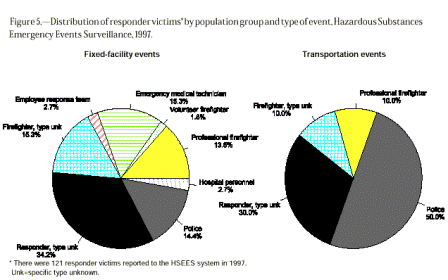
Table 6.--Distribution of type of injury by type of event*, Hazardous Substances Emergency Events Surveillance, 1997.
| TYPE OF INJURY | TYPE OF EVENT | ALL EVENTS | ||||
| FIXED FACILITY | TRANSPORTATION | |||||
| NO. OF INJURIES | (%) | NO. OF INJURIES | (%) | NO. OF INJURIES | (%) | |
| Chemical burns | 38 | (1.3) | 6 | (2.7) | 44 | (1.4) |
| Chest pain | 56 | (1.9) | 0 | (0.0) | 56 | (1.8) |
| Dizziness /CNS† | 286 | (9.8) | 12 | (5.4) | 298 | (9.5) |
| Eye irritation | 349 | (11.9) | 18 | (8.0) | 367 | (11.7) |
| Headache | 385 | (13.2) | 16 | (7.1) | 401 | (12.8) |
| Heat stress | 6 | (0.2) | 2 | (0.9) | 8 | (0.3) |
| Nausea or vomiting | 356 | (12.2) | 10 | (4.5) | 366 | (11.6) |
| Respiratory irritation | 1,138 | (39.0) | 41 | (18.3) | 1,179 | (37.5) |
| Shortness of breath | 27 | (0.9) | 2 | (0.9) | 29 | (0.9) |
| Skin irritation | 122 | (4.2) | 12 | (5.4) | 134 | (4.3) |
| Thermal burns | 17 | (0.6) | 5 | (2.2) | 22 | (0.7) |
| Trauma | 45 | (1.5) | 92 | (41.1) | 137 | (4.4) |
| Other | 96 | (3.3) | 8 | (3.6) | 104 | (3.3) |
| Total | 2,921 | (100.0) | 224 | (100.0) | 3,145 | (100.0) |
* The number of injuries is greater than the number of victims, because a victim could have had more than one injury.
† Central nervous system.

The sex of 85% of the victims was known; of these victims, 56% were male. Among the population groups, more of the responders (93%) and employees (61%) were male. The mean age of the victims was 33 years (range:1-89 years). Most (54%) victims were transported to a hospital and treated on an outpatient basis (Figure 7). Twenty-seven percent of victims were treated at the scene with first aid; 6% were transported and admitted to a hospital; 6% were transported to a hospital for observation; 2% had symptoms within 24 hours after the incident that were associated with the incident and were reported by an official (e.g., personnel with the fire departments, police, or poison control center); 3% were evaluated by a private physician within 24 hours after the incident; and less than 2% died.
Among victims, 68% of employees and 26% of responders had not worn any form of personal protective equipment. Employees who had worn personal protective equipment most frequently wore level "D" protection (28%). The personal protective equipment most frequently worn by first responders was firefighter turnout gear (27%) and level "B" protection (5%).
A total of 28 persons died as a result of hazardous substances emergency events. Five persons died in 1 event, 3 in 1 event, 2 in each of 2 events, and 1 in each of 16 separate events. Unlike previous years of HSEES data collection, the 1997 data involved more deaths resulting from transportation-related events rather than fixed-facility events. Of the 28 fatalities, 25 resulted from transportation-related events. Of the 28 persons who died, 24 were male, 19 were employees, and 9 were members of the general public. There were no deaths among responders, and there were no members of the general public killed in fixed-facility events. Twenty-two of the 28 persons who died had sustained traumatic injuries, 3 had thermal burns, and 3 had both trauma and thermal burns.
Of the 19 employees who died, 13 had not worn personal protective equipment; 1 had worn level "A" protection; and 1 had worn level "D" protection. It was unknown whether the remaining 4 persons had worn personal protective equipment.
Evacuations
Evacuations were ordered in 514 events. Sixty-eight percent of the evacuations were of a building or the affected part of a building. Thirteen percent were of a defined circular area around an event, 11% were based on actual or anticipated downwind dispersion, 5% were based on a circular and downwind or downstream area, and 3% were reported as having been ordered without criteria. The median number of persons evacuated was 20. In 46 events, in-place sheltering was ordered, and instructions regarding precautions to take during in-place sheltering were provided in 31 of these events.
Contingency Plans
The types of contingency or preparedness plans used during an event varied, with 42% involving the use of a company's operating procedures. Thirty-three percent of events were reported as involving the use of an incident-specific ad hoc plan, and 17% involved the use of a hazardous materials (HazMat) or other response team's standard operating procedures.
SULFURIC ACID
Additional analyses were conducted of events involving sulfuric acid to determine their association with the adverse public health consequences of personal injuries and evacuations. Sulfuric acid was the third most commonly released substance reported to the surveillance system during 1997 (Appendix A). A total of 150 releases of sulfuric acid were reported to the system. Of these 150 reported releases, sulfuric acid was the only substance released in 135. Events in which sulfuric acid was the only substance released were used in the analyses. Seventy-two percent of sulfuric acid events occurred at fixed facilities, and 28% were transportation related. For 69% of these releases, there was information on the amount of substance in gallons. The amounts ranged from 1 to 6,000 gallons, with a median of 30 gallons.
Twelve (9%) of the 135 events that only involved sulfuric acid resulted in victims. A total of 50 victims resulted from these 12 events. Victims of the sulfuric acid events were primarily employees (80%) and responders (14%). Six percent of victims were members of the general public. Injuries resulting from these events included respiratory irritation (62%), skin irritation (14%), chemical burns (12%), nausea or vomiting (6%), eye irritation (3%), trauma (2%), and injuries described as "other" (1%). No deaths were associated with sulfuric acid releases. Victims were treated on the scene with first aid (52%), transported and treated at a hospital but not admitted (40%), or were transported and admitted to a hospital (8%).
Evacuations were ordered in 12 (9%) of the 135 events involving only sulfuric acid. Evacuations involved a range of 0 to 200 people. In some events, an evacuation might have been ordered, but the affected persons did not actually leave their homes or places of work. The length of evacuation, available for 67% of events, ranged from 1 to 9 hours.
USE OF HSEES DATA
In 1997, ATSDR continued to respond to requests for HSEES information from local, state, and federal agencies and organizations. In addition, ATSDR continued to receive requests from researchers from various countries and territories for the HSEES protocol and data collection form to help develop similar surveillance systems in their countries. Also, the HSEES data have been used to produce several publications (Appendix B).
Future plans for usage of the HSEES system include the development of an Internet Web site specifically for persons, organizations, and agencies interested in the activities of the HSEES program. This Web site will, initially, provide access to published HSEES annual reports and other information that can be downloaded to a user's personal computer. Internet linkages to other relevant Web sites will be available on the HSEES Web site. Other plans include collaboration with the Federal Chemical Safety and Hazard Investigation Board and other agencies and organizations involved with emergency response, hazardous substances releases, and public health. Additionally, a project is underway to standardize the names of substances so that there will be the opportunity to perform substance-specific analyses in the future.
SUMMARY OF RESULTS, 1990-1997
The number of events, substances released, events with victims, and deaths for the years 1990 through 1997 are shown in Table 7. In the 8 years of data collection, most events have involved a single substance and have occurred at fixed facilities. Respiratory irritation has consistently been reported as the most common injury to victims. In 1997, a total of 28 fatalities were reported to HSEES. This number was slightly less than that reported for 1996, even though the reported number of victims in 1997 was greater than in 1996. Most (89%) of the fatalities occurred as a result of trauma from transportation-related events; however, these deaths were more likely associated with the occurrence of the event, and not with the substance(s) involved.
The percentage of events involving victims has remained at 10% or less since 1994. The higher percentage of events with victims reported in the earlier years, may be due to the under reporting of events without public health consequences, or due to the 1993 case definition change. The decrease in the number of events involving victims could be indicative of increased or strengthened procedures to protect health and safety. However, the number of deaths associated with events continues to suggest the need to evaluate not only the danger posed by exposure to hazardous substances, but also the circumstances surrounding the occurrence of events.
Employees continue to be the most commonly reported victims of emergency events (Figure 8). Cumulative data on the number of events, substances, victims, and events involving victims are displayed in Figure 9. Overall, the results of HSEES data collection have remained fairly consistent throughout the years.
Findings from HSEES data collection efforts can provide useful information regarding risk factors related to the occurrence of emergency events and the associated morbidity and mortality. This information can be used to develop training and health education programs for persons involved in hazardous substances emergency response and planning and for manufacturers and transporters of hazardous materials.
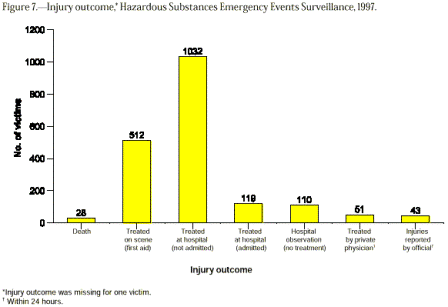
Table 7.--Cumulative data for all states, Hazardous Substances Emergency Events Surveillance, 1990-1997.
| YEAR | NO. OF STATES | TYPE OF EVENT | NO. OF SUBSTANCES RELEASED | NO. OF DEATHS | NO. OF VICTIMS | EVENTS WITH
VICTIMS
# (%)* | |||
| FIXED FACILITY | TRANSPORTATION | TOTAL | |||||||
| 1990 | 5 | 441 | 147 | 588 | 918 | 5 | 476 | 110 | (19) |
| 1991 | 5 | 461 | 200 | 661 | 911 | 2 | 370 | 94 | (14) |
| 1992 | 9 | 1,500 | 376 | 1,876 | 2,221 | 4 | 600 | 263 | (14) |
| 1993† | 11 | 3,303 | 642 | 3,945 | 4,485 | 16 | 2,269 | 486 | (12) |
| 1994† | 12 | 3,333 | 911 | 4,244 | 5,153 | 20 | 2,178 | 414 | (10) |
| 1995† | 14 | 4,310 | 1,041 | 5,351 | 6,166 | 14 | 1,689 | 402 | (8) |
| 1996† | 14 | 4,343 | 1,159 | 5,502 | 5,887 | 33 | 1,620 | 390 | (7) |
| 1997† | 13 | 4,395 | 1,136 | 5,531 | 6,124 | 28 | 1,896 | 372 | (7) |
| TOTAL | 22,086 | 5,612 | 27,698 | 31,865 | 122 | 11,098 | 2,531 | (9) | |
* Percentage of events with victims.
† The definition of a reportable event was expanded to include events involving ALL hazardous substances except events involving only petroleum and petroleum byproducts
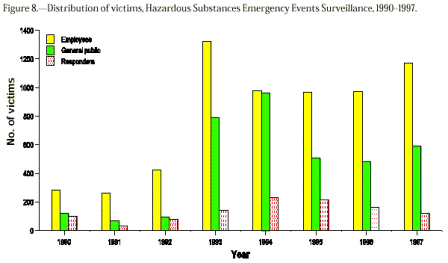
1. Binder S. Death, injuries, and evacuations from acute hazardous materials releases. Am J Public Health 1989; 79:1042-4.
Appendix A--The 100 Most Frequently Released Substances, Hazardous Substances Emergency Events Surveillance, 1997
| Number | Standardized Substance Name | Frequency |
| 1. | Ammonia | 365 |
| 2. | Sulfur Dioxide | 342 |
| 3. | Sulfuric Acid | 150 |
| 4. | Hydrochloric Acid | 147 |
| 5. | Butadiene | 132 |
| 6. | Sodium Hydroxide | 130 |
| 7. | Chlorine | 115 |
| 8. | Paint or Coating | 111 |
| 9. | Ethylene | 109 |
| 10. | Benzene | 105 |
| 11. | Polychlorinated Biphenyls | 87 |
| 12. | Carbon Monoxide | 86 |
| 13. | Ethylene Glycol | 82 |
| 14. | Mercury | 77 |
| 15. | Freon 22 | 59 |
| 16. | Hydrogen Sulfide | 55 |
| 17. | Sodium Hypochlorite | 53 |
| 18. | Mixture: Hydrogen Sulfide/Sulfur Dioxide | 50 |
| 19. | Propylene | 49 |
| 20. | Nitrogen Fertilizer | 48 |
| 21. | Methanol | 38 |
| 22. | Phosphoric Acid | 37 |
| 23. | Indeterminate* | 34 |
| 24. | Nitrogen Dioxide | 33 |
| 25. | Corrosive NOS | 32 |
| 26. | Pendimethalin | 31 |
| 27. | Ethylene Oxide | 30 |
| 28. | Xylene | 30 |
| 29. | Solvent NOS | 30 |
| 30. | Volatile Organic Compound, NOS | 30 |
| 31. | Isopropanol | 27 |
| 32. | Nitric Acid | 27 |
| 33. | Ethanol | 26 |
| 34. | Toluene | 25 |
| 35. | Asbestos | 25 |
| 36. | Potassium Hydroxide | 24 |
| 37. | Methylene Chloride | 23 |
| 38. | Formaldehyde | 21 |
| 39. | Mixture: Nitric Oxide/Nitrous Oxide | 21 |
| 40. | Trifluralin | 21 |
| 41. | Acid NOS | 21 |
| 42. | Hydrofluoric Acid | 20 |
| 43. | Hydrogen Peroxide | 20 |
| 44. | Ammonium Nitrate | 20 |
| 45. | Acetone | 20 |
| 46. | Adhesive NOS | 19 |
| 47. | Hydrocarbon NOS | 19 |
| 48. | Pesticide NOS | 19 |
| 49. | Methyl Mercaptan | 19 |
| 50. | Glyphosate Isopropylammonium | 19 |
| 51. | Nitrogen NOS | 18 |
| 52. | Styrene | 17 |
| 53. | Nitrogen, Phosphorus, Potassium Fertilizer | 16 |
| 54. | Ink NOS | 16 |
| 55. | Nitric Oxide | 16 |
| 56. | Vinyl Chloride | 16 |
| 57. | Ammonium Hydroxide | 16 |
| 58. | Black Liquor | 16 |
| 59. | Calcium Hypochlorite | 16 |
| 60. | Xylene NOS | 15 |
| 61. | Phenol | 15 |
| 62. | Diesel Fuel | 15 |
| 63. | Acetic Acid | 15 |
| 64. | Benzene NOS | 15 |
| 65. | Sulfur | 14 |
| 66. | Mixture: Ethyl Chloride/Methyl Chloride | 14 |
| 67. | Carbon Tetrachloride | 14 |
| 68. | Perchloroethylene | 13 |
| 69. | Fertilizer NOS | 13 |
| 70. | Mix: Isobutane/Polyethylene | 13 |
| 71. | Resin Solution | 13 |
| 72. | Urea | 12 |
| 73. | Mixture: Benzene/Ethyl Benzene/Toluene/Xylene | 12 |
| 74. | Acetylene | 12 |
| 75. | Mixture: Carbon Monoxide/Nitric Oxide/Nitrous Oxide | 12 |
| 76. | Flammable Liquid NOS | 11 |
| 77. | Freon 502 | 11 |
| 78. | Mixture: Hydrogen Sulfide/Volatile Organic Compound NOS | 11 |
| 79. | Propylene Oxide | 11 |
| 80. | Chloroform | 11 |
| 81. | Copper Sulfate | 11 |
| 82. | O-Chlorobenzenylidene Malonitrile | 11 |
| 83. | Malathion | 11 |
| 84. | 2,4-D | 10 |
| 85. | Freon NOS | 10 |
| 86. | Mixture: Ammonia/Carbon Monoxide | 10 |
| 87. | Mixture: Nitrogen Dioxide/Sulfur Dioxide | 10 |
| 88. | Naphtha | 10 |
| 89. | Base NOS | 10 |
| 90. | Freon 13 | 10 |
| 91. | Diethanolamine | 10 |
| 92. | Acrylonitrile | 9 |
| 93. | Ferric Chloride | 9 |
| 94. | Oxidizer NOS | 9 |
| 95. | Hydrazine | 9 |
| 96. | Methyl Ethyl Ketone | 9 |
| 97. | Aluminum Sulfate | 9 |
| 98. | Mixture: Nitric Oxide/Nitrogen Dioxide/Sulfur Dioxide | 9 |
| 99. | Urea-Ammonium Nitrate Fertilizer Solution | 9 |
| 100. | Calcium Hydroxide | 9 |
| Total | 3,726 | |
NOS--Not otherwise specified.
* Unable to assign a standardized name for the substance.
Appendix B--Hazardous Substances Emergency Events Surveillance-Related Publications
Agency for Toxic Substances and Disease Registry. ATSDR update: Hazardous Substances Emergency Events Surveillance (HSEES) system: 1993 data. Health and Environment Digest 1995;8:83-4.
Agency for Toxic Substances and Disease Registry. Hazardous Substances Emergency Events Surveillance System: information for local emergency planning committees and first responders. Atlanta: US Department of Health and Human Services, Public Health Service, 1995.
Agency for Toxic Substances and Disease Registry. Hazardous Substances Emergency Events Surveillance system 1995 annual report. Atlanta: US Department of Health and Human Services, Public Health Service, 1996.
Agency for Toxic Substances and Disease Registry. Hazardous Substances Emergency Events Surveillance system 1994 annual report. Atlanta: US Department of Health and Human Services, Public Health Service, 1995.
Hall HI, Dhara VR, Kaye WE, Price-Green PA. Public health consequences of hazardous substance releases. Toxicol Ind Health 1996;12:289-93.
Hall HI, Dhara VR, Kaye WE, Price-Green PA. Surveillance of hazardous substance releases and related health effects. Arch Environ Health 1994;49:45-8.
Hall HI, Dhara VR, Price-Green PA, Kaye WE. Surveillance for emergency events involving hazardous substances-United States, 1990-1992. MMWR 1994;43(No. SS-2):1-6.
Hall HI, Haugh GS, Price-Green PA, Dhara VR, Kaye WE. Risk factors for hazardous substance releases that result in injuries and evacuations: data from 9 states. Am J Public Health 1996;86: 855-7.
Hall HI, Price-Green PA, Dhara VR, Kaye WE. Health effects related to releases of hazardous substances on the Superfund priority list. Chemosphere 1995;31:2455-61.
For general information you can now contact the ATSDR Information Center toll-free at 1-888-422-8737 or by E-mail at ATSDRIC@cdc.gov.Other HSEES documents available:
1995 Annual Report [HTML] [![]() ]
]
1996 Annual Report [HTML] [![]() ]
]
1997 Annual Report [![]() ]
]
1998 Annual Report [HTML] [![]() ]
]
1999-2000 Biennial Report [HTML]
[![]() ]
]
2001 Annual Report [HTML] [![]() ]
]
2002 Annual Report [ HTML] [![]() ]
]
2003 Annual Report [HTML] [ ![]() ]
]
2004 Annual Report [HTML] [ ![]() ]
]
1993 through 1997 Annual Report [HTML] [![]() ]
]
1998 through 2001 Annual Report [HTML] [![]() ]
]


